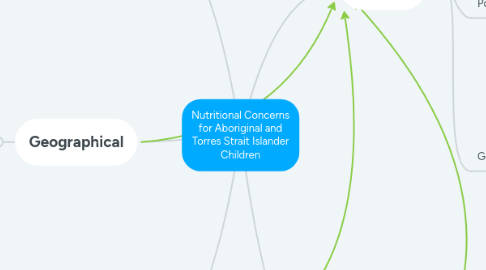
1. Physical
1.1. Illness and Disease
1.1.1. Hospitalization
1.1.1.1. Health care system burden
1.1.2. Co-morbidities
1.1.2.1. Oral health
1.1.2.1.1. Cavities
1.1.2.1.2. Decay
1.1.2.2. Dermatological conditions
1.1.2.3. Future health risks
1.1.2.3.1. Diabetes
1.1.2.3.2. Cardiovascular disease
1.2. Poor nutrition
1.2.1. Obesity
1.2.1.1. Over consumption of unhealthy food
1.2.1.2. Nutritional deficiencies
1.2.2. Under nutrtion
1.2.2.1. Failure to thrive
1.2.2.1.1. Poor child growth and development
1.2.2.2. Malnutrition
1.3. Genetic characteristics
1.3.1. Family history of disease
1.3.2. Poor pregnancy nutrition
1.3.2.1. Lack of antenatal care
1.3.2.2. Discriminatory services
1.3.3. Poor perinatal outcomes
1.3.3.1. Low birth weight
1.3.3.2. Large birth weight
2. Social
2.1. Education
2.1.1. Lack of nutritional awareness
2.1.2. Lack of role models
2.2. Socioeconomic disadvantage
2.2.1. Reduced access to sanitary and quality foods
2.2.2. Housing instability
2.2.2.1. Family disruptions
2.3. Unemployment
2.3.1. Substance misuse
2.3.2. Financial stress
2.3.2.1. Food insecurity
2.3.2.1.1. Hunger
2.3.2.1.2. Poverty
2.4. Family Emotional Wellbeing
2.4.1. Mental health concerns
3. Environmental
3.1. Weather
3.1.1. No access for food delivery
3.1.1.1. Unpredictable, seasonal dependent
3.2. Transport
3.2.1. Limits delivery of resources
3.2.2. Reliant on outside sources
3.3. Housing
3.3.1. Overcrowding
3.3.1.1. Frequent movement
3.3.2. Working Facilities
3.3.2.1. Food storage, preparation and consumption
3.3.2.1.1. Food safety
4. Geographical
4.1. Isolation
4.1.1. Safe water
4.1.1.1. Drinking
4.1.1.2. Cleaning
4.1.2. Reduced variety of quality food
4.1.2.1. Lack of fresh produce
4.2. Rural and remote communities
4.2.1. Increased freight costs
4.2.1.1. Expensive healthy food
4.2.1.2. Cheaper unhealthy food
4.3. Insufficient waste removal
4.3.1. Garbage disposal
4.3.1.1. Unsanitary living conditions
4.3.2. Sewage
5. Historical
5.1. Transgenerational impacts
5.1.1. Loss of traditional food sources
5.2. Inequity
5.2.1. Racism
5.2.2. Discrimination

